Digital Marketing Performance Analysis: Telstra vs. Competitors
VerifiedAdded on 2023/05/28
|5
|1126
|402
Report
AI Summary
This report analyzes the digital marketing strategies of Telstra Company Limited, a major telecommunications company in Australia. It examines Telstra's approach to digital marketing, including its initial focus on a dedicated digital network group and the implementation of various digital initiatives. The report discusses both successful and unsuccessful strategies, such as the use of social media and the development of an electronic health service. It also compares Telstra's strategies to those of its competitor, Optus, highlighting the importance of customer focus and digital engagement. The analysis covers the challenges faced by Telstra, including issues with decision-making, and the impact of these challenges on the company's performance. The report concludes by assessing the effectiveness of Telstra's digital marketing efforts and providing insights into the company's overall performance in the market. This report is a comprehensive look at Telstra's digital marketing journey, providing a clear overview of its strategies, successes, and failures.
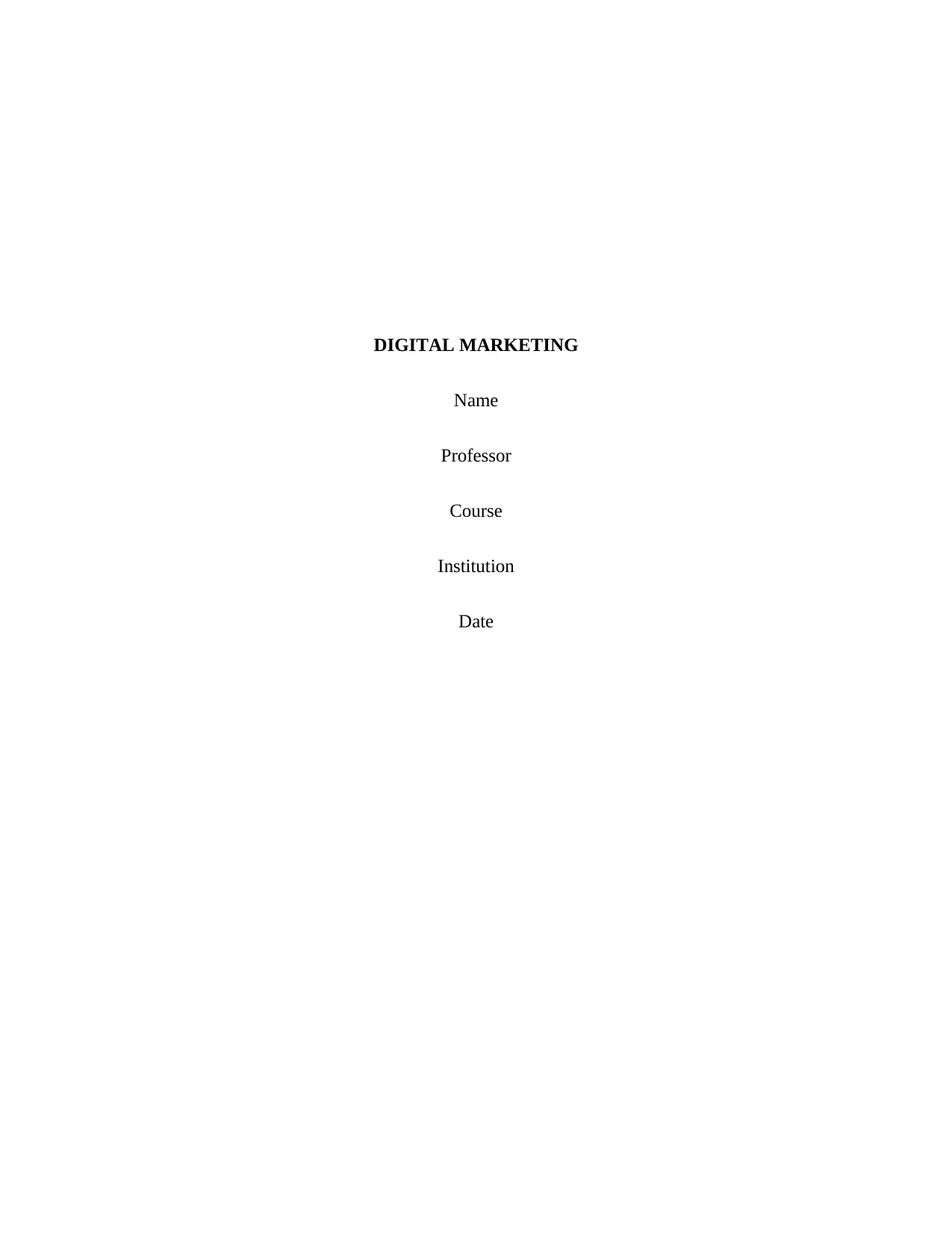
DIGITAL MARKETING
Name
Professor
Course
Institution
Date
Name
Professor
Course
Institution
Date
Paraphrase This Document
Need a fresh take? Get an instant paraphrase of this document with our AI Paraphraser
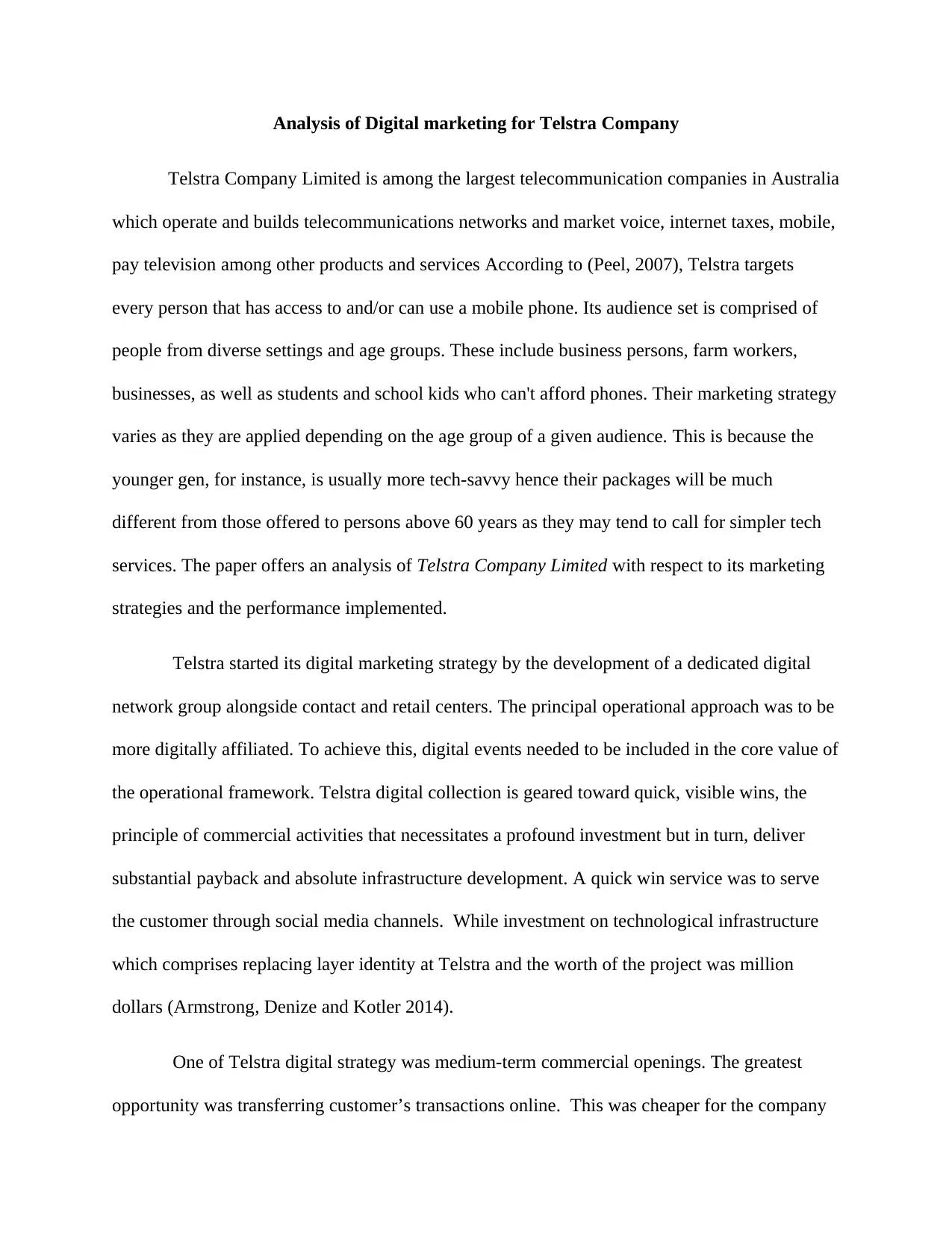
Analysis of Digital marketing for Telstra Company
Telstra Company Limited is among the largest telecommunication companies in Australia
which operate and builds telecommunications networks and market voice, internet taxes, mobile,
pay television among other products and services According to (Peel, 2007), Telstra targets
every person that has access to and/or can use a mobile phone. Its audience set is comprised of
people from diverse settings and age groups. These include business persons, farm workers,
businesses, as well as students and school kids who can't afford phones. Their marketing strategy
varies as they are applied depending on the age group of a given audience. This is because the
younger gen, for instance, is usually more tech-savvy hence their packages will be much
different from those offered to persons above 60 years as they may tend to call for simpler tech
services. The paper offers an analysis of Telstra Company Limited with respect to its marketing
strategies and the performance implemented.
Telstra started its digital marketing strategy by the development of a dedicated digital
network group alongside contact and retail centers. The principal operational approach was to be
more digitally affiliated. To achieve this, digital events needed to be included in the core value of
the operational framework. Telstra digital collection is geared toward quick, visible wins, the
principle of commercial activities that necessitates a profound investment but in turn, deliver
substantial payback and absolute infrastructure development. A quick win service was to serve
the customer through social media channels. While investment on technological infrastructure
which comprises replacing layer identity at Telstra and the worth of the project was million
dollars (Armstrong, Denize and Kotler 2014).
One of Telstra digital strategy was medium-term commercial openings. The greatest
opportunity was transferring customer’s transactions online. This was cheaper for the company
Telstra Company Limited is among the largest telecommunication companies in Australia
which operate and builds telecommunications networks and market voice, internet taxes, mobile,
pay television among other products and services According to (Peel, 2007), Telstra targets
every person that has access to and/or can use a mobile phone. Its audience set is comprised of
people from diverse settings and age groups. These include business persons, farm workers,
businesses, as well as students and school kids who can't afford phones. Their marketing strategy
varies as they are applied depending on the age group of a given audience. This is because the
younger gen, for instance, is usually more tech-savvy hence their packages will be much
different from those offered to persons above 60 years as they may tend to call for simpler tech
services. The paper offers an analysis of Telstra Company Limited with respect to its marketing
strategies and the performance implemented.
Telstra started its digital marketing strategy by the development of a dedicated digital
network group alongside contact and retail centers. The principal operational approach was to be
more digitally affiliated. To achieve this, digital events needed to be included in the core value of
the operational framework. Telstra digital collection is geared toward quick, visible wins, the
principle of commercial activities that necessitates a profound investment but in turn, deliver
substantial payback and absolute infrastructure development. A quick win service was to serve
the customer through social media channels. While investment on technological infrastructure
which comprises replacing layer identity at Telstra and the worth of the project was million
dollars (Armstrong, Denize and Kotler 2014).
One of Telstra digital strategy was medium-term commercial openings. The greatest
opportunity was transferring customer’s transactions online. This was cheaper for the company
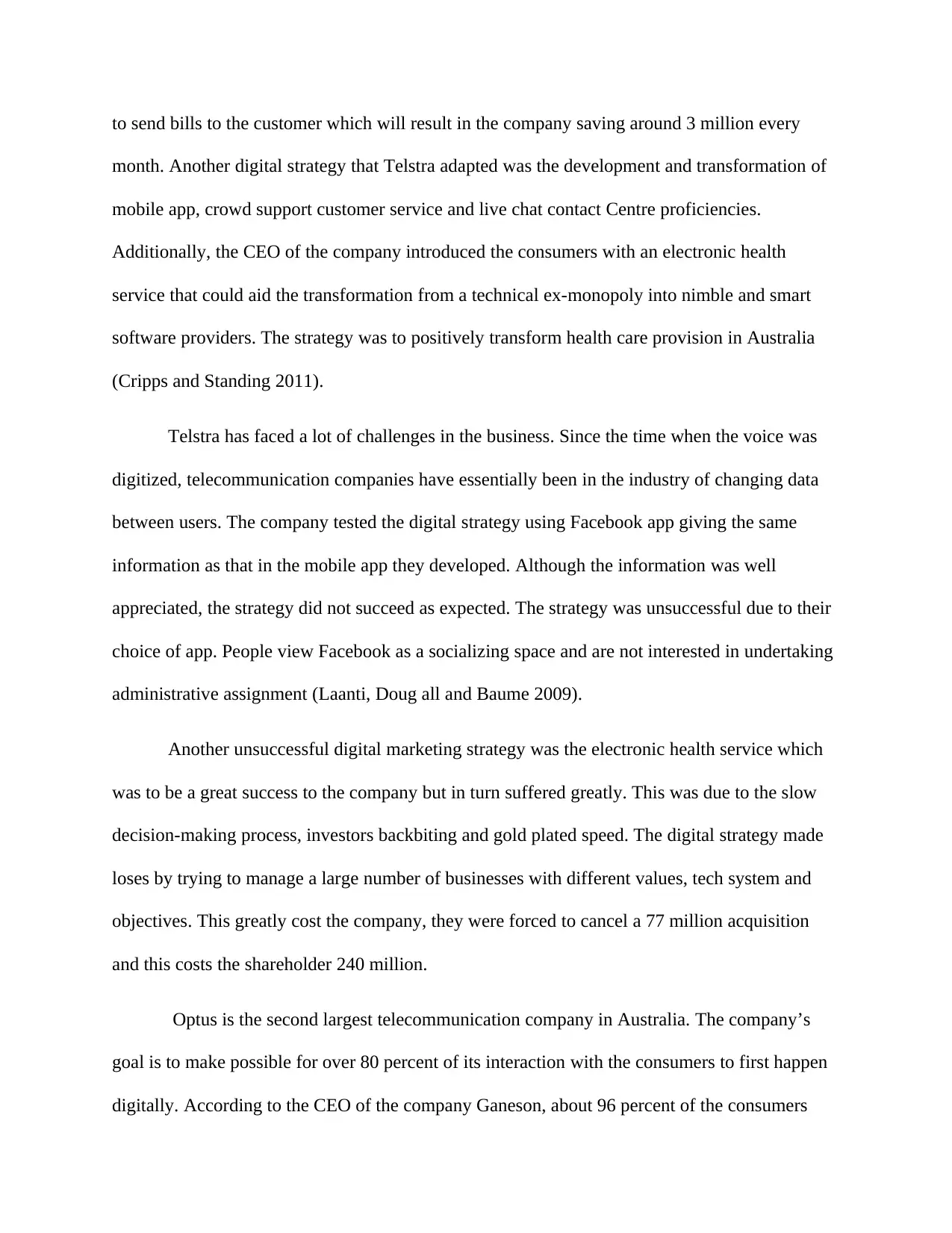
to send bills to the customer which will result in the company saving around 3 million every
month. Another digital strategy that Telstra adapted was the development and transformation of
mobile app, crowd support customer service and live chat contact Centre proficiencies.
Additionally, the CEO of the company introduced the consumers with an electronic health
service that could aid the transformation from a technical ex-monopoly into nimble and smart
software providers. The strategy was to positively transform health care provision in Australia
(Cripps and Standing 2011).
Telstra has faced a lot of challenges in the business. Since the time when the voice was
digitized, telecommunication companies have essentially been in the industry of changing data
between users. The company tested the digital strategy using Facebook app giving the same
information as that in the mobile app they developed. Although the information was well
appreciated, the strategy did not succeed as expected. The strategy was unsuccessful due to their
choice of app. People view Facebook as a socializing space and are not interested in undertaking
administrative assignment (Laanti, Doug all and Baume 2009).
Another unsuccessful digital marketing strategy was the electronic health service which
was to be a great success to the company but in turn suffered greatly. This was due to the slow
decision-making process, investors backbiting and gold plated speed. The digital strategy made
loses by trying to manage a large number of businesses with different values, tech system and
objectives. This greatly cost the company, they were forced to cancel a 77 million acquisition
and this costs the shareholder 240 million.
Optus is the second largest telecommunication company in Australia. The company’s
goal is to make possible for over 80 percent of its interaction with the consumers to first happen
digitally. According to the CEO of the company Ganeson, about 96 percent of the consumers
month. Another digital strategy that Telstra adapted was the development and transformation of
mobile app, crowd support customer service and live chat contact Centre proficiencies.
Additionally, the CEO of the company introduced the consumers with an electronic health
service that could aid the transformation from a technical ex-monopoly into nimble and smart
software providers. The strategy was to positively transform health care provision in Australia
(Cripps and Standing 2011).
Telstra has faced a lot of challenges in the business. Since the time when the voice was
digitized, telecommunication companies have essentially been in the industry of changing data
between users. The company tested the digital strategy using Facebook app giving the same
information as that in the mobile app they developed. Although the information was well
appreciated, the strategy did not succeed as expected. The strategy was unsuccessful due to their
choice of app. People view Facebook as a socializing space and are not interested in undertaking
administrative assignment (Laanti, Doug all and Baume 2009).
Another unsuccessful digital marketing strategy was the electronic health service which
was to be a great success to the company but in turn suffered greatly. This was due to the slow
decision-making process, investors backbiting and gold plated speed. The digital strategy made
loses by trying to manage a large number of businesses with different values, tech system and
objectives. This greatly cost the company, they were forced to cancel a 77 million acquisition
and this costs the shareholder 240 million.
Optus is the second largest telecommunication company in Australia. The company’s
goal is to make possible for over 80 percent of its interaction with the consumers to first happen
digitally. According to the CEO of the company Ganeson, about 96 percent of the consumers
⊘ This is a preview!⊘
Do you want full access?
Subscribe today to unlock all pages.

Trusted by 1+ million students worldwide
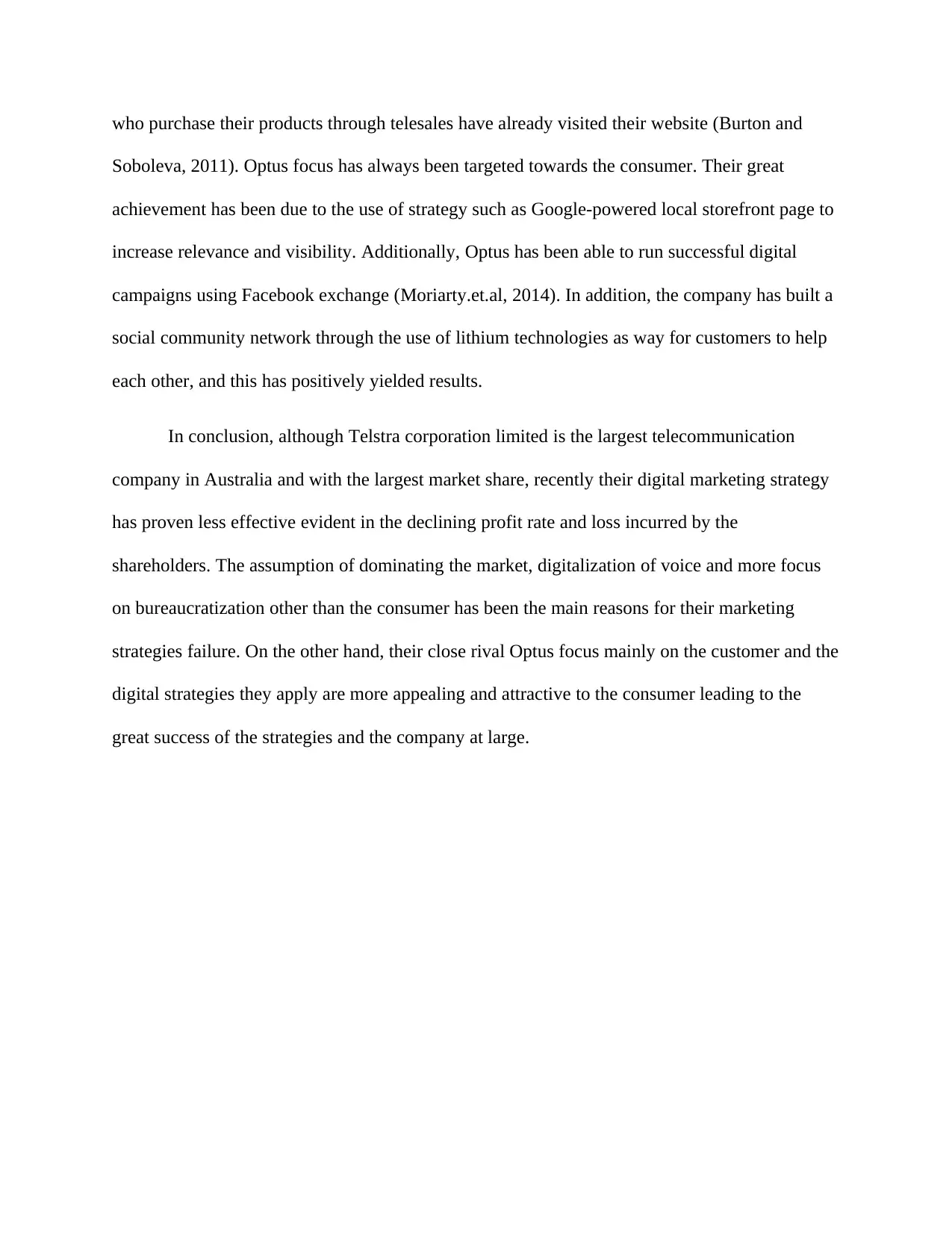
who purchase their products through telesales have already visited their website (Burton and
Soboleva, 2011). Optus focus has always been targeted towards the consumer. Their great
achievement has been due to the use of strategy such as Google-powered local storefront page to
increase relevance and visibility. Additionally, Optus has been able to run successful digital
campaigns using Facebook exchange (Moriarty.et.al, 2014). In addition, the company has built a
social community network through the use of lithium technologies as way for customers to help
each other, and this has positively yielded results.
In conclusion, although Telstra corporation limited is the largest telecommunication
company in Australia and with the largest market share, recently their digital marketing strategy
has proven less effective evident in the declining profit rate and loss incurred by the
shareholders. The assumption of dominating the market, digitalization of voice and more focus
on bureaucratization other than the consumer has been the main reasons for their marketing
strategies failure. On the other hand, their close rival Optus focus mainly on the customer and the
digital strategies they apply are more appealing and attractive to the consumer leading to the
great success of the strategies and the company at large.
Soboleva, 2011). Optus focus has always been targeted towards the consumer. Their great
achievement has been due to the use of strategy such as Google-powered local storefront page to
increase relevance and visibility. Additionally, Optus has been able to run successful digital
campaigns using Facebook exchange (Moriarty.et.al, 2014). In addition, the company has built a
social community network through the use of lithium technologies as way for customers to help
each other, and this has positively yielded results.
In conclusion, although Telstra corporation limited is the largest telecommunication
company in Australia and with the largest market share, recently their digital marketing strategy
has proven less effective evident in the declining profit rate and loss incurred by the
shareholders. The assumption of dominating the market, digitalization of voice and more focus
on bureaucratization other than the consumer has been the main reasons for their marketing
strategies failure. On the other hand, their close rival Optus focus mainly on the customer and the
digital strategies they apply are more appealing and attractive to the consumer leading to the
great success of the strategies and the company at large.
Paraphrase This Document
Need a fresh take? Get an instant paraphrase of this document with our AI Paraphraser
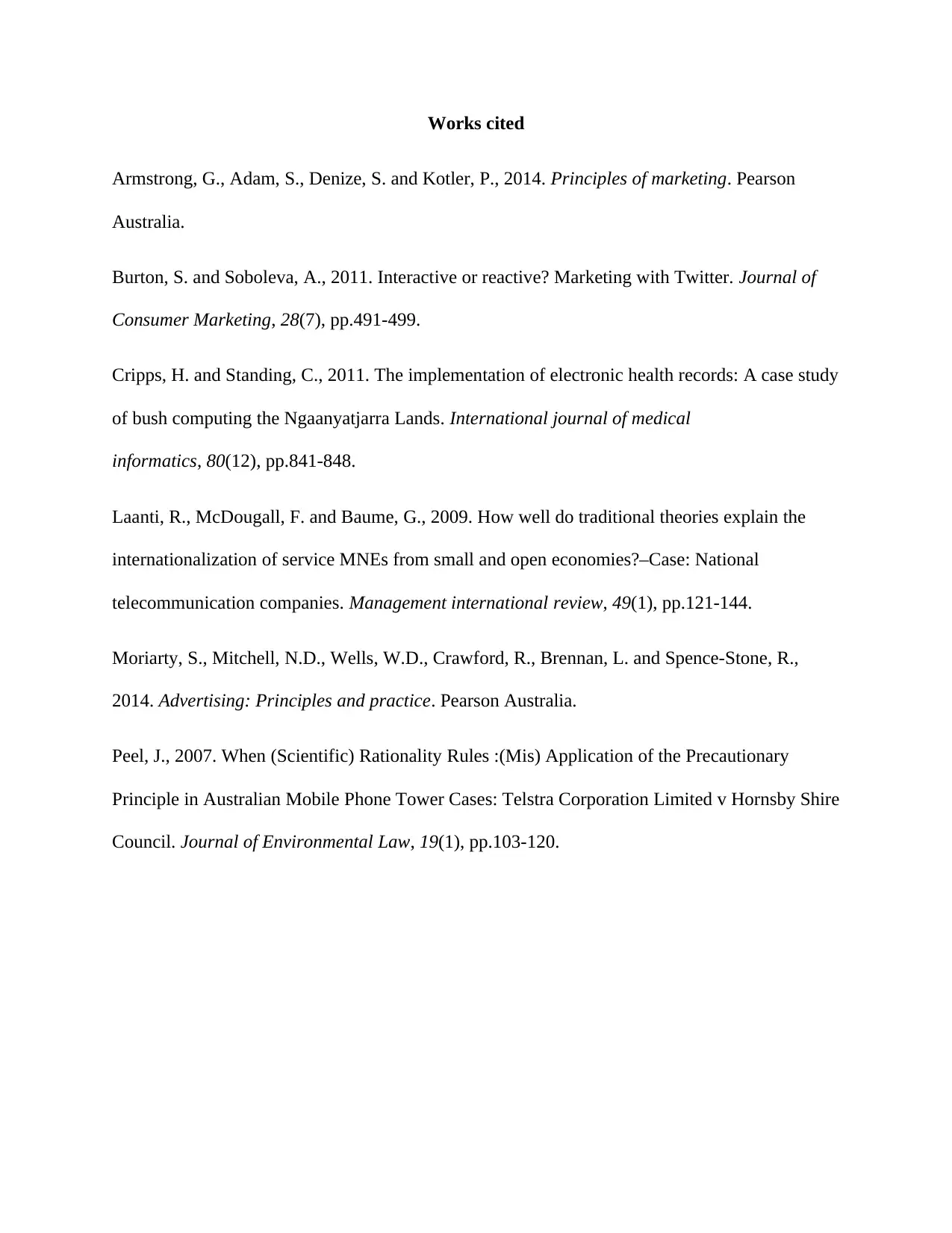
Works cited
Armstrong, G., Adam, S., Denize, S. and Kotler, P., 2014. Principles of marketing. Pearson
Australia.
Burton, S. and Soboleva, A., 2011. Interactive or reactive? Marketing with Twitter. Journal of
Consumer Marketing, 28(7), pp.491-499.
Cripps, H. and Standing, C., 2011. The implementation of electronic health records: A case study
of bush computing the Ngaanyatjarra Lands. International journal of medical
informatics, 80(12), pp.841-848.
Laanti, R., McDougall, F. and Baume, G., 2009. How well do traditional theories explain the
internationalization of service MNEs from small and open economies?–Case: National
telecommunication companies. Management international review, 49(1), pp.121-144.
Moriarty, S., Mitchell, N.D., Wells, W.D., Crawford, R., Brennan, L. and Spence-Stone, R.,
2014. Advertising: Principles and practice. Pearson Australia.
Peel, J., 2007. When (Scientific) Rationality Rules :(Mis) Application of the Precautionary
Principle in Australian Mobile Phone Tower Cases: Telstra Corporation Limited v Hornsby Shire
Council. Journal of Environmental Law, 19(1), pp.103-120.
Armstrong, G., Adam, S., Denize, S. and Kotler, P., 2014. Principles of marketing. Pearson
Australia.
Burton, S. and Soboleva, A., 2011. Interactive or reactive? Marketing with Twitter. Journal of
Consumer Marketing, 28(7), pp.491-499.
Cripps, H. and Standing, C., 2011. The implementation of electronic health records: A case study
of bush computing the Ngaanyatjarra Lands. International journal of medical
informatics, 80(12), pp.841-848.
Laanti, R., McDougall, F. and Baume, G., 2009. How well do traditional theories explain the
internationalization of service MNEs from small and open economies?–Case: National
telecommunication companies. Management international review, 49(1), pp.121-144.
Moriarty, S., Mitchell, N.D., Wells, W.D., Crawford, R., Brennan, L. and Spence-Stone, R.,
2014. Advertising: Principles and practice. Pearson Australia.
Peel, J., 2007. When (Scientific) Rationality Rules :(Mis) Application of the Precautionary
Principle in Australian Mobile Phone Tower Cases: Telstra Corporation Limited v Hornsby Shire
Council. Journal of Environmental Law, 19(1), pp.103-120.
1 out of 5
Related Documents
Your All-in-One AI-Powered Toolkit for Academic Success.
+13062052269
info@desklib.com
Available 24*7 on WhatsApp / Email
![[object Object]](/_next/static/media/star-bottom.7253800d.svg)
Unlock your academic potential
Copyright © 2020–2025 A2Z Services. All Rights Reserved. Developed and managed by ZUCOL.




